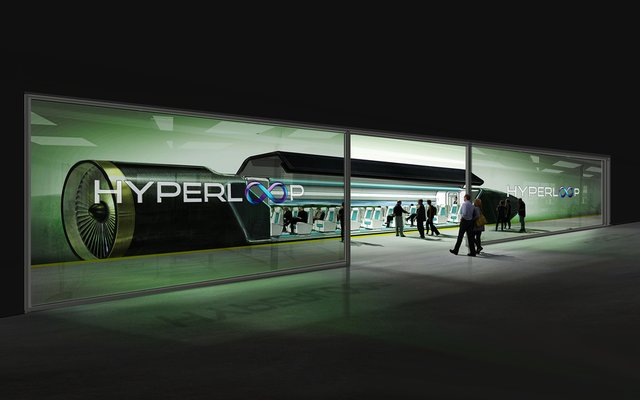Elon Musk 700 MPH Hyperloop - Our Future
Tesla and SpaceX's Elon Musk has started the building revolution for a new train system dubbed Hyperloop. It will mean getting from London to Edinburgh or LA to San Francisco in under 30 minutes. But what is it and how does it work?
The Hyperloop is essentially a futuristic train that Musk calls "a cross between a Concorde, a railgun and an air hockey table". It's based on the very high speed transit (VHST) system proposed in 1972 which combines a magnetic levitation train and a low pressure transit tube. It evolves some of the original ideas of VHST, but still uses tunnels and pods or capsules to move from place to place. Musk has likened it to a vacuum tube system in a building used to move documents from place to place.
Companies have sprung up from the proposed idea and are now working to make Hyperloop a reality. A 5-mile test loop track will start this year in Quay Valley on a site owned by Hyperloop Transportation Technologies.
So how does the Hyperloop transit system work?
Air bearings or maglev
One of the biggest problems with anything moving, is friction, both against surfaces and the environment the pod is moving though. Hyperloop proposes to move away from traditional wheels by using air bearings for pods instead. This will have the pod floating on air.
It's similar to maglev in which the electromagnetic levitation of the train means there is no friction like a traditional train that runs on tracks. This is how current maglev trains can achieve super speeds, like the 500km/h maglev train in Japan.
Another proposal, from Hyperloop Transportation Technologies, uses passive magnetic levitation, meaning the magnets are on the trains and work with aluminium track. Current active maglev needs powered tracks with copper coiling, which can be expensive.
The Hyperloop will take this to the next level by travelling through low pressure tubes.
Low pressure
The Hyperloop will be built in tunnels that have had some of the air sucked out to lower the pressure. So, like high altitude flying, there's less resistance against the pod moving through the tunnel, meaning it can be much more energy efficient, something that's highly desirable in any transit system.
The original VHST proposed using a vacuum, but there's an inherent difficulty in creating and maintaining a vacuum in a tunnel that will have things like stations, and any break in the vacuum could potentially render the entire system useless.
For Hyperloop, the idea is to lower the air pressure, a job that could be done by regularly placed air pumps. Low pressure, however means you still have some air in the tunnels.
The air bearing and passive maglev ideas are designed not only to levitate the pod, but also see the pod moving through the air, rather than pushing the air infront of it and dragging it along behind. The air cushion will see the air pumped from the front of the pod to the rear via these suspension cushions.
The tunnels envisioned are metal tubes, elevated as an overground system. Musk has suggested that solar panels running on the top of the tunnels could generate enough electricity to power the system. It could also run as an underground system too.
What speeds are proposed?
Hyperloop is being proposed as an alternative to short distance air travel, where the system will be much faster than existing rail networks and much cleaner that flight. Hyperloop isn't about going as fast as possible, because you'll have to deal with high G forces when it came to turns, which isn't ideal for passenger travel.
Speeds of over 700mph are suggested for journeys, but there are practical implications that have to be considered on a short stop-start journey, such as the acceleration and deceleration sensation that passengers would go through.
When will the Hyperloop arrive?
At the moment Elon Musk has merely announced the Hyperloop is going to be made. There is going to be a 1-mile track built by SpaceX adjacent to Hawthorne, its California headquarters. The plan is to have a competition for students with their various pod designs in the summer of 2016.
The planning documents that have already been shown off planned a route between LA and San Francisco, a 354-mile journey, that would cost around $6 billion in construction. This is based on a passenger-only model whereas one that can also transport vehicles too would be $7.5 billion. This extra expenditure would be worth it since more people could use the system, offering potentially larger returns.
Initially there will be pod testing from student candidates in the proposed competition. Musk is even thinking of having pod races.
Shervin Pishevar, co-founder and chairman of Hyperloop Technologies, aims to shuttle passengers and cargo in high-speed pods that are smaller than most planes and trains and designed to depart as often as every 10 seconds. He told CNBC: "Hyperloop will be operational, somewhere in the world, by 2020."
Hyperloop Transportation Technologies is looking into a setup that would link Slovakia, Austria and Hungary. This is the same company that plans to create the 5-mile test loop in California by 2018.
How much will Hyperloop cost?
According to Hyperloop Transportation Technologies CEO Dirk Ahlborn the cost of a ticket should be around $30 mark to get a passenger from LA to San Francisco. That, he says, should allow the company to pay back its initial costs in eight years. Weather this will actually be the final price of a ticket remains to be seen.
#steemit #technology #future #steem #human #train #transportation #elonmusk #tesla

Elon Musk on Twitter: Hyperloop pod run by team WARR — Steemit